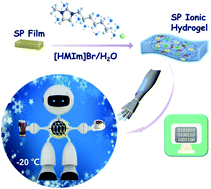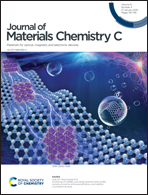Adaptable ionic liquid-containing supramolecular hydrogel with multiple sensations at subzero temperatures†
Abstract
There is a challenge to prepare a hydrogel devoted to fabricate a form of multi-responsive skin-like sensors piggybacking on tactile controlled robots, which could grab the soft and fragile items at subzero temperatures. Herein, we demonstrate a supramolecular ionic liquid hydrogel wherein ureidopyrimidinone (UPy) containing hydrophilic polyurethane (PU) was employed as the network while the aqueous solution of imidazolium ionic liquid acted as a free phase. Combining the advantages of hydrophilic PEG segments, hydrophobic UPy moieties, and the imidazolium ionic liquid, this supramolecular hydrogel exhibited high water content (∼86%), swelling ratio (∼400%), elongation (∼750%), low resistivity (∼0.51 kΩ cm) and excellent transparency (∼98%). Moreover, the most striking characteristic was that the supramolecular hydrogel maintained its outstanding mechanical and thermal sensitivity at subzero temperatures, e.g., −20 °C. The supramolecular ionic liquid hydrogel was utilized to fabricate E-skin for the intelligent robot to realize pressure feedback and thermal recognition. This line of research not only demonstrates that anti-freezing stimuli-responsive hydrogels are a promising candidate for E-skins used in harsh conditions, but also contribute to the design and application of supramolecular polymer-based hydrogel sensors for future artificial intelligence applications.



 Please wait while we load your content...
Please wait while we load your content...